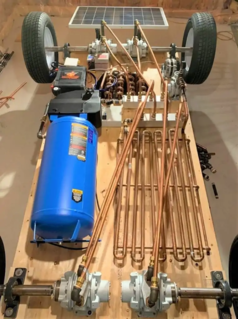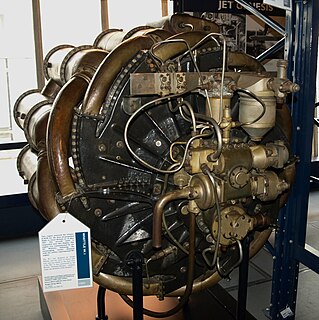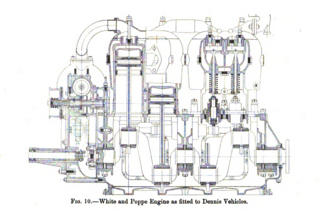Related Research Articles

A jet engine is a type of reaction engine discharging a fast-moving jet that generates thrust by jet propulsion. While this broad definition can include rocket, water jet, and hybrid propulsion, the term jet engine typically refers to an internal combustion airbreathing jet engine such as a turbojet, turbofan, ramjet, or pulse jet. In general, jet engines are internal combustion engines.

Air Commodore Sir Frank Whittle, was an English engineer, inventor and Royal Air Force (RAF) air officer. He is credited with inventing the turbojet engine. A patent was submitted by Maxime Guillaume in 1921 for a similar invention; however, this was technically unfeasible at the time. Whittle's jet engines were developed some years earlier than those of Germany's Hans von Ohain who designed the first operational turbojet engine.

A gas turbine, also called a combustion turbine, is a type of continuous and internal combustion engine. The main elements common to all gas turbine engines are:

The turbojet is an airbreathing jet engine, typically used in aircraft. It consists of a gas turbine with a propelling nozzle. The gas turbine has an air inlet which includes inlet guide vanes, a compressor, a combustion chamber, and a turbine. The compressed air from the compressor is heated by burning fuel in the combustion chamber and then allowed to expand through the turbine. The turbine exhaust is then expanded in the propelling nozzle where it is accelerated to high speed to provide thrust. Two engineers, Frank Whittle in the United Kingdom and Hans von Ohain in Germany, developed the concept independently into practical engines during the late 1930s.

The Rover Company Limited was a British car manufacturing company that operated from its base in Solihull in Warwickshire. Its lasting reputation for quality and performance was such that its first postwar model reviewed by Road & Track in 1952 was pronounced finer than any but a Rolls-Royce. Rover also manufactured the Land Rover series from 1948 onwards, which spawned the Range Rover in 1970, and went on to become its most successful and profitable product — with Land Rover eventually becoming a separate company and brand in its own right.

A compressed-air vehicle (CAV) is a transport mechanism fueled by tanks of pressurized atmospheric gas and propelled by the release and expansion of the gas within a Pneumatic motor.
Metropolitan-Vickers, Metrovick, or Metrovicks, was a British heavy electrical engineering company of the early-to-mid 20th century formerly known as British Westinghouse. Highly diversified, they were particularly well known for their industrial electrical equipment such as generators, steam turbines, switchgear, transformers, electronics and railway traction equipment. Metrovick holds a place in history as the builders of the first commercial transistor computer, the Metrovick 950, and the first British axial-flow jet engine, the Metropolitan-Vickers F.2. Their factory in Trafford Park, Manchester, was for most of the 20th century one of the biggest and most important heavy engineering facilities in Britain and the world.

Ruston & Hornsby was an industrial equipment manufacturer in Lincoln, England founded in 1918. The company is best known as a manufacturer of narrow and standard gauge diesel locomotives and also of steam shovels. Other products included cars, steam locomotives and a range of internal combustion engines, and later gas turbines. It is now a subsidiary of Siemens.

Maurice Fernand Cary Wilks was a British automotive and aeronautical engineer, and by the time of his death in 1963, was the chairman of the Rover Company, a British car manufacturer. He was the founder of the Land Rover marque and responsible for the inspiration and concept work that led to the development of the first Land Rover off-road utility vehicle.
The General Motors Firebird comprises a quartet of prototype cars that General Motors (GM) engineered for the 1953, 1956, and 1959 Motorama auto shows. The cars' designers, headed by Harley Earl, took Earl's inspiration from the innovations in fighter aircraft design at the time. General Motors never intended the cars for production, but rather to showcase the extremes in technology and design that the company was able to achieve. The cars recently joined the display at the Henry Ford Museum in Dearborn, Michigan, and still make regular car show appearances. The tradition of offering prototype vehicles continued with the Pontiac Banshee series.

The Bluebird-Proteus CN7 is a gas turbine-powered vehicle that was driven by Donald Campbell and achieved the world land speed record on Lake Eyre in Australia on 17 July 1964. The vehicle set the FIA world record for the flying mile at 403.1 mph (648.7 km/h).

The Armstrong Siddeley, later Bristol SiddeleyGamma was a family of rocket engines used in British rocketry, including the Black Knight and Black Arrow launch vehicles. They burned kerosene fuel and hydrogen peroxide. Their construction was based on a common combustion chamber design, used either singly or in clusters of up to eight.

Power Jets was a British company set up by Frank Whittle for the purpose of designing and manufacturing jet engines. The company was nationalised in 1944, and evolved into the National Gas Turbine Establishment.

Various scientists and engineers contributed to the development of internal combustion engines. In 1791, the English inventor John Barber patented a gas turbine. In 1794 Thomas Mead patented a gas engine. Also in 1794 Robert Street patented an internal-combustion engine, which was also the first to use liquid fuel (petroleum) and built an engine around that time. In 1798, John Stevens designed the first American internal combustion engine. In 1807, French engineers Nicéphore and Claude Niépce ran a prototype internal combustion engine, using controlled dust explosions, the Pyréolophore. This engine powered a boat on the Saône river, France. The same year, the Swiss engineer François Isaac de Rivaz built and patented a hydrogen and oxygen powered internal-combustion engine. The fuel was stored in a balloon and the spark was electrically ignited by a hand-operated trigger. Fitted to a crude four-wheeled wagon, François Isaac de Rivaz first drove it 100 meters in 1813, thus making history as the first car-like vehicle known to have been powered by an internal-combustion engine. In 1823, Samuel Brown patented the first internal combustion engine to be applied industrially in the U.S.; one of his engines pumped water on the Croydon Canal from 1830 to 1836. He also demonstrated a boat using his engine on the Thames in 1827, and an engine-driven carriage in 1828. Father Eugenio Barsanti, an Italian engineer, together with Felice Matteucci of Florence invented the first real internal combustion engine in 1853. Their patent request was granted in London on June 12, 1854, and published in London's Morning Journal under the title "Specification of Eugene Barsanti and Felix Matteucci, Obtaining Motive Power by the Explosion of Gasses". In 1860, Belgian Jean Joseph Etienne Lenoir produced a gas-fired internal combustion engine. In 1864, Nicolaus Otto patented the first atmospheric gas engine. In 1872, American George Brayton invented the first commercial liquid-fueled internal combustion engine. In 1876, Nicolaus Otto, working with Gottlieb Daimler and Wilhelm Maybach, patented the compressed charge, four-stroke cycle engine. In 1879, Karl Benz patented a reliable two-stroke gas engine. In 1892, Rudolf Diesel developed the first compressed charge, a compression ignition engine. In 1926, Robert Goddard launched the first liquid-fueled rocket. In 1939, the Heinkel He 178 became the world's first jet aircraft. In 1954 German engineer Felix Wankel patented a "pistonless" engine using an eccentric rotary design.

The Rover-BRM was a prototype gas turbine-powered racing car, jointly developed in the early 1960s by the British companies Rover and British Racing Motors (BRM).
A liquid nitrogen vehicle is powered by liquid nitrogen, which is stored in a tank. Traditional nitrogen engine designs work by heating the liquid nitrogen in a heat exchanger, extracting heat from the ambient air and using the resulting pressurized gas to operate a piston or rotary motor. Vehicles propelled by liquid nitrogen have been demonstrated, but are not used commercially. One such vehicle, Liquid Air was demonstrated in 1902.
Arthur Goddard is an English-Australian engineer who worked at the Rover Company from 1945 to 1957 and was in charge of the Land Rovers engineering development from 1947 to 1957. He is the second son of John Newman Goddard. Goddard went to the Little Sutton Church of England Primary School in Ellesmere Port, Cheshire. After schooling he completed a Mechanical Engineering Certificate at a college in Liverpool. He turned 100 in January 2021.
The Leyland 2S gas turbine was developed by British Leyland to power road vehicles. The original version, the 2S/150 was famous for its use in a series of racing cars in the 1960s. In 1968, the basic layout was used to develop the larger 2S/350 for use in semi-trailers. The 2S/350 was also used in the British Rail APT-E train. Both were used only experimentally, development ended in the 1970s.

Peter August Poppe was a Norwegian-born engineer, designer and developer of engines and complete motor vehicles for the British motor industry. He was a co-founder of the engine manufacturer White and Poppe.
George John Huebner Jr. was an American executive engineer who worked for the Chrysler Corporation. While in his twenties he worked for the Central Engineering Division at Chrysler developing new technology in mechanical engineering using science. It was long-term concepts he worked on that didn't come to fruition for some ten to twenty years. He researched an experimental gas turbine engine for passenger automobiles. A version of this engine was later installed and used as the main motorization for certain military tanks worldwide.
References
- ↑ "NPT301 Turbojet". Minijets website.
- ↑ "British Gas Turbines". www.gasturbineworld.co.uk. Retrieved 7 June 2017.
- ↑ Hunt, Ronald J. (January 2011). "The History of the Industrial Gas Turbine (Part 1 The First Fifty Years 1940 - 1990)" (PDF). www.idgte.org. The Institution of Diesel and Gas Turbine Engineers. p. 22. Retrieved 7 June 2017.
- ↑ Bagot-Cob, Martin (10 June 2013). "Turbine pioneer dies aged 87". Coventry Telegraph. Retrieved 7 June 2017.
- ↑ Mortimer, John (2015). The 'nearly' engine: gas turbines in vehicles (2nd ed.). Milton Keynes: J Mortimer. ISBN 9781326177072 . Retrieved 7 June 2017.